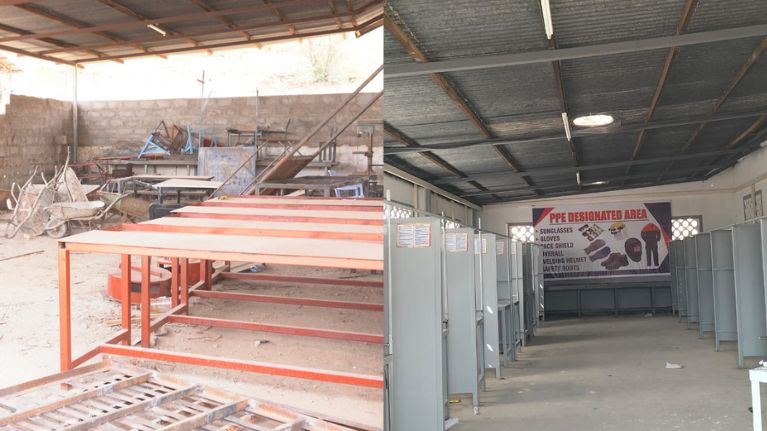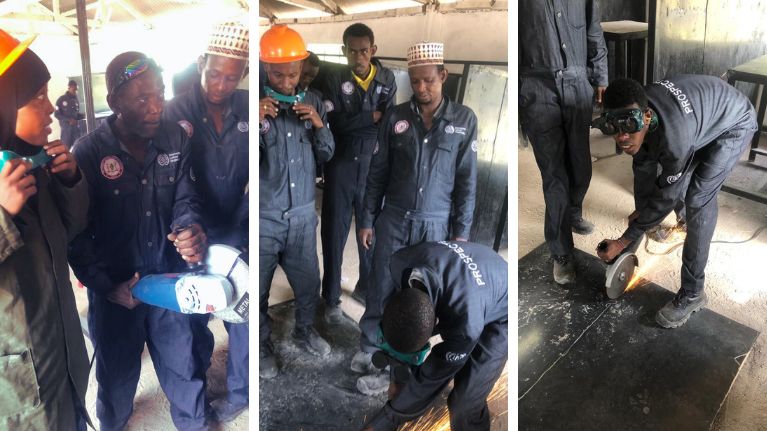With upgraded infrastructure and capacity, vocational training centres in Kenya are creating better job prospects for youth
With the support of ILO PROSPECTS, vocational training centres are being equipped with the latest machinery and infrastructure facilities, while staff are being trained to deliver industry-relevant competency-based curricula. These investments will reduce the skills gap and improve employability of host and refugee community youth in the region.
GARISSA-TURKANA, Kenya (ILO news) – Kenya is facing an unprecedented unemployment crisis. In 2021, 5.7 per cent of Kenya’s labour force was out of work, the highest rate in East Africa which had an average of 2.7 per cent. The numbers were critical among the youth - 18 to 34 years old – with over 11 per cent of them seeking work or reported having no work available. (The world bank, 2021)
Garissa and Turkana Counties fall within the arid and semi-arid lands (ASAL) region and are also the principal refugee-hosting regions in Kenya where the ILO PROSPECTS programme situates its interventions. These counties are home to over 35 per cent of the country’s population but rank lowest on development and infrastructure indicators. Marginalized in terms of public and private investments, these regions are facing an escalating unemployment challenge, especially among young people, and could face a serious socio-economic crisis.
However, the recent government devolution efforts will allow oil and gas exploration in these regions which is offering some hope for the future. In addition, the strategic location of these counties in the upcoming Lamu Port-South Sudan-Ethiopia-Transport (LAPSSET) Corridor is expected to generate new employment opportunities.
“It is against this backdrop that we formed a partnership between the ILO and the County Governments of Turkana and Garissa to improve the skills base of host and refugee communities. The partnership is working with the Counties’ Departments of Vocational Training to address unemployment challenges by promoting skills and knowledge that are demand-driven and highly relevant in the job market,” said Caroline Njuki, Chief Technical Advisor, for ILO PROSPECTS in Kenya.

In 2021, the ILO piloted a dual learning programme on industrial welding skills to train 70 young people, including 25 refugees, at the East African Institute of Welding in Nairobi. The Competency-Based Education and Training (CBET) curriculum introduced with the support of the ILO provided students with market relevant skills. Sixty-eight trainees successfully graduated from the pilot programme and 17 managed to find employment. In order to achieve scale and ensure sustainability, the ILO and the county governments are now working together to enhance the capacity of other TVET centres in the region.
Strengthening institutions to ensure sustainability
By offering market-relevant skills, TVET institutions provide youth an opportunity to address skills gaps in the labour market and improve their employability. In this way, these institutions contribute to the targets of Sustainable Development Goal (SDG) 4 on “Ensuring inclusive and equitable quality education and promoting lifelong learning opportunities for all” and SDG 8 on ”Decent work and economic growth”.“Local TVET centres help youth and adults develop the abilities, knowledge, values and attitudes they need to find decent work. Our programme helped to strengthen the capacities of the local TVET centres to deliver market-driven skills, particularly those which can lead to employment in the upcoming infrastructure development and oil and gas sectors in the counties. We focused on the institutionalization of these new skilling programmes within local TVET centres to ensure that they remain accessible for local youth in the longer term,” explained Geofrey Ochola, National Programme Coordinator for Skills, ILO PROSPECTS Kenya.

The ILO conducted a needs assessment of TVET centres in both counties to evaluate their capacity to implement Competency-Based Training in Welding and Fabrication. The assessment was benchmarked against nationally recognized standards, Curriculum Development, Assessment and Certification Council (CDACC) Level 4 and ISO 9606 and found that the centres required support in three key areas: human resources, infrastructure and equipment.
Building human resource capacity
The needs assessment indicated that TVET centres lacked CBET curriculum trainers, assessors and verifiers registered with the Technical and Vocational Education and Training Authority (TVETA) in Kenya. It was therefore important to build the capacity of trainers on CBET curriculum.In 2022, 15 trainers, including two women, were selected to be part of a Training of Trainers (ToT) programme. This was structured in four parts, each running concurrently to deliver the following: competency-based training integrating practical training in specialized welding skills; training and registration to be a certified online and on-site trainer for the Kenya Teachers Training College; work-based learning in the industry; and certification to deliver the ISO 9606 International Institute of Welding curriculum.
“The training was aimed at strengthening the capacity of the county governments to design, coordinate and implement blended dual-training programmes which can be replicated in other technical fields in future,” added Ochola.
Improved infrastructure and equipment
The ILO also assessed the quality of workshop buildings at TVET centres to be able to provide CBET. In order to develop a replicable model, two selected institutions, Lodwar and Garissa TVET Centres, were provided with upgraded classrooms, welding workshops and electricity connections. They were also equipped with a range of equipment, including welding machines, grinders, vices and training resources, based on industry standards and to ensure that students could attain all CDACC level 4 and ISO 9606 competencies.
“In PROSPECTS, our objective is to upgrade the TVET centres to the level of centres of excellence in industrial welding training. During the pilot, we worked closely with Kenya County Directorate of TVET and we learned from the East Africa Institute of Welding (EAIW) about the standards required for welding workshops. We replicated the same model of high standards, equipment and safety measures in Lodwar and Garissa TVET centres,” informed Ochola.
Roll-out of welding skills training
On completion of staff training and improved infrastructure, the ILO has now sponsored 140 young people from Garissa and Turkana counties to receive competency-based welding skills training at the local TVET centres.The government is championing CBET as the future of technical training. The approach ensures that students do not just learn theoretical knowledge, but also understand its practical application following industry standards. Apart from technical skills, the training will include modules on numeracy, communication, entrepreneurship, employability and environmental literacy.
With the dual-learning approach, the institutional training will be followed by six months work-based learning where trainees will be attached to a commercial welding enterprise. It will provide them with an exposure to industry standards and practices and an opportunity to apply their classroom learning in a professional set up. The students will also be taken through the ILO’s Start and Improve Your Business (SIYB) programme which will encourage students to also consider setting up their own enterprises.

Trainees have been provided with appropriate personal protective equipment, such as auto-darkening welding glasses, helmets, gloves and fire-resistant overalls, to mitigate the risk of injury both in the centre and at the workplace. This protective equipment and learning about safety are an integral part of the programme to orient trainees on appropriate standards of health and safety required in the welding sector and to embed a ‘safety culture’ in students from training to employment or enterprise creation.
On successful completion of the course, the trainees will receive a nationally accredited certificate helping them to seek employment or further improve their skills in line with the Kenya National Qualifications Framework. “We hope to build a strong partnership between the training institutions and industry to achieve a balance between demand and supply of labour and goods produced through welding processes,” says Njuki.
“The ILO has had a positive impact on the future of TVET centres in Garissa County. The perception of the community towards TVET courses has improved. They are no longer seen as a last resort, but rather a preferred career choice. We have been receiving requests from the community for upgrading other courses like electrical, motor vehicle mechanic and plumbing to similar high standards of the industrial welding course. The perception of policy-makers, political leadership and stakeholders in the county on TVET has also improved due to high-level advocacy spearheaded by the ILO,” says Hassan Yarrow, Director of TVET, Garissa County.